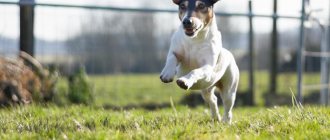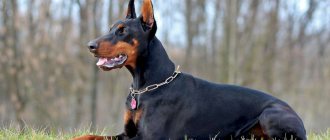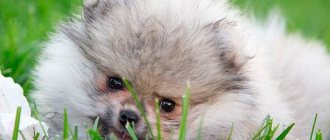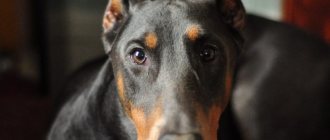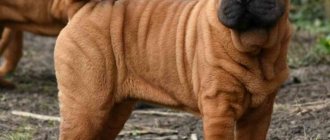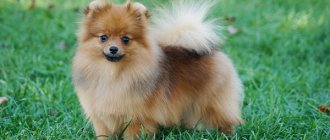Dogs, throughout their entire history of existence, were considered excellent guards, good defenders, and simply loyal friends. Recently, many breeds have changed a lot. We may not recognize a species known to us due to its unusual size or unusual color. An example would be the white Doberman.
Do you know the history of the appearance of the Doberman breed? Do you know about the existence of a white Doberman? If not yet, be sure to read the article.
According to standard
According to the breed standard adopted by the FCI, only two color variations of the Doberman Pinscher are allowed:
- Black and tan with clearly demarcated tan markings.
- Dark brown and tan.
In this case, the scorch marks should not be located in a chaotic order. The standard clearly defines their correct location. Doberman dogs should have tan on the face, above the eyebrows, on the neck, on the chest, on the underside of the paws, on the inside of the thighs, under the tail and on the ischial tuberosities.
The standard does not allow darkening or lightening of tan, the presence of white marks, or tan in any other places except those listed above.
Price range
Since the blue color is considered a breeding choice, these puppies are usually less expensive than the standard black and brown and tan.
The price range for these dogs is quite large: from 5-8 to 25-30 thousand rubles.
At the same time, the cost of a puppy depends not only on its quality, but on the ambitions of the breeder.
Choosing a nickname
For Dobermans, nicknames should be chosen based on their appearance. These are beautiful, intelligent dogs that are often recruited to serve in the army or police. The Doberman makes a wonderful protector.
The following names are suitable for boys of this breed:
- Emphasizing their strength and physical development: Atlas, Opal, Sunset, Zeus, Pharaoh, Caesar, Hercules, Achilles, Vulcan, Ararat, Sultan, Conan, Gloom, Circassian, Titan, Sherkhan, Elbrus;
- Nicknames that focus on color: Chocolate, Walnut, Ash, Black, Coal, Amber, Yakhont, Truffle;
- Nicknames that echo German names: Albert, Hans, Askold, Karl, Oscar, Jan, Nicholas, Rudolf, Theodor, Schultz, Richard, Jurgen, Max, Michael, Jurgen;
- Nicknames that emphasize the qualities of temperament (after all, how many dogs have so many characters): Rogue, Golden, Friend, Wind, Tango, Cyclone, Miracle, Glorious, Frisky, Fakir, Fire, Mars, Leader, Success, Hurricane, Champion, Romeo, Pilot, Indigo, Storm, Bulldog.
The following nicknames are suitable for girls of the Doberman breed:
- The most aristocratic nicknames that will emphasize the elegant, beautiful and graceful appearance of your dog: Hera, Ariadne, Star, Melisa, Roxy, Liana, Venus, Diva, Bagheera, Aelita, Naomi, Shelly, Stephanie, Yasmin, Aurora, Giselle, Luna, Paula, Camellia.
- To emphasize the temperament of your pet, give the following nicknames: Aida, Love, Verona, Gloria, Clear, Audrey, Oda, Blizzard, Fun, Muse, Night, Sonata, Melody, Doll, Prima, Fairy, Fortune, Charade, Ethiopian, Riddle, Rocket.
Puppies
Knowledge of breed development norms will allow you to detect violations in time and take appropriate measures.
Below are the average height and weight standards for a Doberman puppy by month:
| Age (months) | Height boy/girl (cm) | Weight boy/girl (cm) |
| 1 | 27/22 | 3,8/3,5 |
| 2 | 40/33 | 8,7/7,8 |
| 3 | 49/43 | 14/12,3 |
| 4 | 56/50 | 18,5/16,5 |
| 5 | 60/55 | 22,6/22,2 |
| 6 | 64/58 | 26/23 |
| 7 | 66/60 | 27,9/24,6 |
| 8 | 68/62 | 29,6/25,5 |
| 9 | 69/63 | 31,1/26,7 |
| 10 | 70/64 | 33/27,5 |
| 11 | 71/65 | 34/28 |
| 12 | 72/65 | 35/29 |
White
White color in dogs is associated with the albinism gene and is quite rare. Outwardly, these dogs look original: their white or light cream coat is combined with blue eyes that are unusual for the breed and a pink or flesh-colored nose. In the recent past, white dogs of this breed were considered rare and highly valued. But later it was found that the absence of pigment in them may be genetically associated with a number of diseases and pathologies.
For example, among white Dobermans there are animals suffering from congenital deafness or vision problems. In addition, they are too sensitive to ultraviolet radiation and have weaker immunity than colored dogs.
White albino Dobermans are characterized by unpredictability of behavior, increased nervousness, and sometimes cowardice.
It is believed that they are less suitable for service use than dogs of other colors, since they are not very healthy and often have mental problems.
Genetics of Doberman colors
From the RKF/FCI standard: “Color: Black or dark brown with rusty-red, reddish-red clearly defined and clean tan markings. The tan is located on the muzzle in the form of spots on the cheeks and above the upper eyelids, on the throat, on the chest in the form of two spots, on the pasterns, metatarsals and paws, on the inner surfaces of the thighs, around the anus and on the ischial tuberosities.”
The main genes of the Doberman color: at (tan) - determines the development of the tan color, typical of all representatives of the breed B - determines the synthesis of black eumelanin, promotes the formation of the black and tan color b - determines the synthesis of brown eumelanin, promotes the formation of the brown and tan color D (normal color intensity) – determines the normal density of pigments in all layers of the hair. Promotes the development of color of normal intensity. Present in black and tan and brown and tan representatives of the breed d (weakening of color) - promotes lightening of color, causes the formation of blue and isabella colors E - promotes the distribution of eumelanin throughout the dog’s body, present in all representatives of the breed Em (presence of a dark mask) - may observed in dogs with excessive shading on the face e – prevents the spread of eumelanin throughout the dog’s body, G (age-related lightening of color) – g (absence of age-related lightening) – present in all representatives of the breed K (dominant solid eumelanin color) ky is absent in the breed – allows alleles at , is present in all representatives of the breed P (Pallid) – causes a color of normal intensity p – recessive allele of the locus, in the homozygous state causes one of the types of albinism, contributes to the formation of the white color of Dobermans S (color without spots ) – causes the formation of a solid color without spots s (white spotting) – causes the presence of white spots, the slightest signs of which in the breed are considered defective
Tan color
Dobermans have a classic tan color, one might say, a standard one. This color has very specific, distinct outlines, clearly stated in the standard. The scorch marks have a constant length and are located in strictly defined places.
The tan pattern is symmetrical spots with clear boundaries, pure red or red, without intermediate transitional tones. Located on the cheeks and eyebrows of the muzzle, under the larynx, two triangles on the chest, on the inner surface of the shoulders and thighs, as well as on the pasterns, metatarsals, paws and around the anus.
Puppies of tan dogs are born with a pronounced pattern, which with age only slightly expands and acquires greater clarity of outline.
The color-forming genes for the tan color are the recessive a t at and k y ky . The black and tan color of a Doberman is formed if the dog has genes that determine the synthesis of black eumelanin ( B ), brown and tan - if the dog has genes bb , which determine the synthesis of brown eumelanin. The intensity of the tan color, which can vary from chestnut red to red, depends on a number of genetically determined factors.
Genetic formulas of standard Doberman colors: a t a t B-DEk y k y S- – black and tan a t a t bbD-E- y k y S- – brown and tan
Disadvantages and defects of color
The main disadvantages of tan color in dogs of all breeds are: - too much or too little extent of tan marks, - unclean tan caused by the presence of black hairs or stripes on a red background, - insufficient clarity of the pattern, - excessive shading or, on the contrary, lightening of tan marks and the main tone color - the presence of white markings.
Excessive lightening of tan marks is associated with genetic factors that directly affect pheomelanin. Excessive darkening of the muzzle, and sometimes the front of the body and limbs, can be initiated by the presence of a dark mask caused by the presence of the Em . Excessive or insufficient extent of tan marks may be associated with the presence of modifier genes that work against the background of tan genes a t a t .
Disqualifying faults
From the standard: “White spots, lack of tan spots, diffuse tan marks, making the color close to black.”
White spots are initiated by the presence of ss . Since the standard does not allow Dobermans to have any white markings, it can be assumed that the frequency of these alleles in the breed is low.
Modifications of the tan color, bringing it closer to the black color, occur in the presence of specific modifier genes that work together with the tan genes.
Non-standard Doberman colors
Currently, the problem of non-standard colors is becoming larger and larger. They can also appear due to the presence of certain recessive genes in the gene pool of the breed and due to episodic crossbreeding, which is not uncommon in some countries. It should be noted that the most common non-standard colors of the Doberman are problematic from the point of view of the dog’s health.
– Lightened colors: blue and Isabella d has long existed in the Doberman gene pool . If a dog has a pair of recessive dd , a lightened color is formed. With a t a t B-ddkyk y – blue (lightened black) and a t a t bbdd kyk y – isabella (lightened brown). Moreover, the effect of dd may manifest itself differently in eumelanin and pheomelanin zones. The eumelanin (black and brown) color zones lighten noticeably more, while the pheomelanin zones, i.e. tan zones often retain almost normal intensity. Thus, blue and isabella colors with slightly lightened red tan are formed. But in addition to the dd , a number of other genetic factors can also affect the intensity of the tan color and the degree of overall lightening of the color.
Blue and Isabella Dobermans often have skin problems. In particular, the so-called “color dilution alopecia” ( CDA ) is associated with these genotypes. It is sometimes called "colored dog alopecia" or "blue Doberman syndrome." Alopecia is a form of ectodermal dysplasia, namely, a disorder of the development of hair follicles, leading to hair loss. Signs of CDA are symmetrical patches of hair loss that usually start on the sides, thighs or along the spine and gradually spread lower and lower. Puppies are born with a healthy coat; by 4–6 months it becomes thinner and the hair becomes brittle and dry. The skin becomes rough and covered with dandruff. Acne, papules and pustules appear on the body. The dog's coat becomes thin, dry and brittle, and baldness can be complete. Some Blue Dobermans become ill after the age of three. As studies show, dogs of similar colors, in addition to skin problems, often have reduced overall vitality, in particular, deterioration in the functions of some sense organs and the immune system. The decrease in vitality is especially pronounced in Dobermans of Isabella color. Apparently, the complex of recessive genes a t a t bbdd has a pleiotropic effect on various physiological processes. It is interesting to note that dogs of other breeds with similar colors are much less likely to have similar problems. It is likely that this is due to some specific structural features of the Doberman's connective tissue, which results in dogs of this breed being prone to dilated cardiomyopathy (DCM).
Isabella color
It should be noted that the causes of “diminished color alopecia” have not been fully elucidated. For example, the following is put forward as one of the possible hypotheses.
One of the hypotheses about alopecia
Under the influence of alleles that initiate color lightening, a modification of the processes of melanocytes occurs, which leads to the sticking together of pigment granules into random groups - macromelanosomes. As a result, the uniform supply of pigment to the growing hair is disrupted, which leads to the appearance of individual voids in the hair shaft and uneven accumulation of granules in different areas of the hair. This, in turn, leads to a strong decrease in light absorption by hair tissue and a phenotypic weakening of color. Macromelanosomes can be randomly grouped in the outer layer of the hair, layered on top of each other and thereby distorting the outer shell of the hair - the cuticle. This distortion of the cuticle contributes to hair brittleness and the formation of alopecia. It is hypothesized that rupture of the hair sheath releases pigmentation byproducts that poison the hair follicles. Regrowth of broken hair is difficult due to the damage to the follicles caused by these toxins. In the Doberman breed, such alopecia is observed in 50–80% of dogs with weakened color. But, at the same time, in dogs of many breeds with lightened colors, for example, Great Danes, Newfoundlands, Cane Corsos, Weimaraners, Chihuahuas, Miniature Pinschers, Italian Greyhounds, and others, cases of alopecia are practically not observed, and among blue Dobermans there are also quite healthy individuals . Toy terriers have both healthy animals and those prone to alopecia. In this regard, it has been suggested that in locus D there are several alleles that cause weakening of color: d - lightening of color, not accompanied by alopecia, and dl , directly associated with alopecia (Teri Dickinson, dvm The Italian Greyhound, XXXVII, I) . Both alleles can exist simultaneously in the gene pool of a breed. Thus, dogs with the dd are light-colored dogs with normal healthy coat, dd l are an intermediate variant (dogs with a mild form of the disease), and dogs with the d l d l are affected by alopecia of weakened color. Dogs of the Dd l have a rich color, but are carriers of alopecia of a weakened color. It is likely that the blue and isabella colors of the Doberman are caused precisely by the d l , and not by the d , as previously assumed. It is possible that both of these alleles occur in the breed. However, molecular genetic confirmation of the existence of the d l has not yet been obtained. At the same time, molecular genetic studies show the presence of wide polymorphism of proteins in the D . Individual alleles have not yet been identified, but the assumption about the possibility of the existence in this locus of other recessive alleles with a similar effect that contributes to a weakening of color is quite legitimate. Thus, in particular, two recessive alleles have been described in cats at a similar locus. A number of similar alleles have been described in mice.
Due to genetically determined health problems in Europe, there is a ban on breeding Dobermans of blue and Isabella color. And these colors have been removed from the standard ones. However, in America all four Doberman colors are still recognized. Blue and Isabella Dobermans fully participate in breeding and are allowed to participate in exhibitions. The Doberman Club of America, recognizing the difficulty of keeping dogs of these colors, gives owners recommendations on the specifics of caring for the problematic coat of blue and Isabella Dobermans and the specifics of feeding them.
From left to right: Isabella, brown and tan, blue, black and tan colors
Genetic formulas of lightened Doberman colors a t a t B-ddЕ- kyk yS — – blue color a t a t bbddЕ- kyk y S- – Isabella color
– White color The white color of Dobermans is also one of the problematic ones. The birth of a white Doberman was first recorded in 1976. Research has shown that this color is caused by different genes than the white color of most other breeds, namely the recessive allele p (pallid). This color is one of the types of albinism; it manifests itself in homozygous carriers of the pp . These dogs have a white or cream-colored coat with a bronze tint, and the skin and mucous membranes appear pink due to translucent blood vessels. Eyes may be red or blue. The lack of pigments leads to damage to the eyes and skin: photophobia, susceptibility to sunburn, cutaneous keratoses and basal cell carcinomas. Albinism is often accompanied by myopia, astigmatism, and strabismus. In some cases, a decrease in intelligence, deafness, hypotrichosis, and developmental defects may be observed. Albinism of this type may be associated with such eye pathologies as, for example, nystagmus, strabismus, depigmentation of the fundus with protruding vessels, photophobia, decreased visual acuity, hypoplasia of the optic fossa, myopia, astigmatism, color blindness, macular hypoplasia, optic nerve dysplasia. Lack of pigments can lead to a variety of hearing and balance abnormalities. These are, for example, albinism-deafness syndrome, vestibular hypofunction, sensorineural hearing loss, hearing loss in heterozygous carriers, and head tremor. The mental instability of these dogs is also noted. Due to these anomalies, the white color of Dobermans is not standard. But, nevertheless, in the USA there are many fans of these dogs. There are entire nurseries specializing in their breeding.
How to choose?
It should be remembered that it will not be possible to find a blue Doberman with documents of origin in Russia. This means that the future owner of such a pet will have to either buy a puppy without registration, or go to a foreign kennel to get the dog.
IMPORTANT!
Buying a puppy without documents is always fraught with the risk that the baby may have health problems or an unstable psyche.
If the decision to adopt a dog of this particular color is finally made, then you need to try to find a baby from dogs that have medical certificates.
When choosing a future pet, you need to give preference to a baby who does not show signs of cowardice or, conversely, aggression.
Origin story and what it looks like in the photo
When the founder of the breed, Karl Friedrich Lewis Doberman, set out to create the perfect police dog that could also be a bodyguard dog, he used many other breeds in breeding animals, including Great Danes and, presumably, Weimaraners.
For these dogs, blue color is typical and, as researchers believe, it was thanks to the blood of Great Danes or Weimar pointers that the first steel-gray Dobermanns with rusty-red tan marks appeared.
In 1901, the blue color of the Doberman Pinschers was recognized as standard along with black and brown.
However, after genetic research carried out at the end of the 20th century, it was found that the gene for blue color in Dobermans is associated with some hereditary diseases.
The risk of possible health problems was the reason that the blue color was excluded from the FCI standard in 1994.
Blue and Isabella
These colors were once considered standard, but later dogs with this coat color were excluded from breeding. This was primarily due to the fact that the weakened black gene makes animals of blue or isabella color predisposed to diseases such as dermatitis, allergies and demodicosis. In addition, animals with lightened colors often have low immunity. Because of this, they are more susceptible to infections.
Not all breeders have abandoned their breeding, since the unusual appearance and rarity of such dogs currently make blue and Isabella Dobermans a real exclusive.
The blue color can vary from silver-gray to dark lead. It has reddish or reddish markings.
The Isabella coat color of representatives of this breed can be described as beige-blue. Often a pinkish or lilac tint is also noticeable. Tan is also present, but may be lighter than the standard black and tan or brown and tan colors.
Marriage or breed?
Currently, the blue and tan color is considered a breeding defect..
Expert opinion
Kozhevin Semyon Kirillovich
Expert dog handler.
“The blue color of Dobermans looks unusual and impressive. But the weakening of the black pigment to a grayish-blue led to skin diseases becoming common in the breed. Therefore, the blue and tan color was eventually dropped from the official standard. If now there are advertisements for the sale of such puppies, then you need to understand that they were obtained from animals that do not have permission for breeding and that no one can guarantee how healthy they will be.”
Caring for an Albino
If the goal is to get a loving pet, assistant and faithful family friend, then you should not separate the dog from yourself. You should not trust the advice of keeping a Doberman in an outdoor enclosure, especially an albino. In an apartment, dogs feel just great. Smooth and short hair without much shedding does not cause trouble for owners.
The main thing to do with a Doberman is to provide him with physical activity on a daily basis, in addition, do not leave the dog alone for a long time. If all family members work and there is no one in the house all day, you can make a Doberman friend in the form of another dog, they will become good companions. In this case, the dogs will simply have no time to be bored.
Important! It is necessary to walk with the animal daily for at least 2 hours. These athletic dogs need to be given exercise along with a walk, as they are very athletic and energetic.
As for wool, it needs to be cleaned with a special brush or mitten once a week. You can simply wipe the dog with a damp cloth, which is also an effective cleaning.
You should bathe your dog only if necessary, as the coat becomes dirty. You can only wash your paws after a walk every day. To clean fur when bathing, you should use only special products from pet stores. Human soaps and shampoos are not suitable for Dobermans or any other dog.
Additionally, it is necessary to trim the claws when they grow up. In the summer you don’t have to do this, they wear off well on the asphalt, but in the winter the procedure needs to be carried out several times a month.
Character and behavior
The character of the Doberman can be described in one word - vigilant. High intelligence allows the dog to objectively assess current events and make the right decisions in any situation. The dog is moderately aggressive towards strangers, has an average threshold of excitability, and is obedient and hardworking. This is not a fighting breed, so it is not characterized by unmotivated anger.
Because of its cropped ears, the pet looks very menacing, but in reality it is friendly and loyal.
This is an almost universal animal. Due to their character traits, representatives of the breed can be companions, guards or service dogs. Expert opinion
Leonid Rodin
Experienced dog breeder
Ask a Question
The Doberman is a fighter. Many of his qualities do not require special training. For example, he will protect the owner even without taking a course in protective guard sciences. It is not for nothing that the Doberman Pinscher was the main working dog of the American army during the Second World War. The legendary Cappy became famous for saving the lives of 250 Marines during a Japanese attack. A vigilant four-legged watchman guarded the camp and sensed the approach of enemy troops. But trained dogs were forbidden to bark during the fighting. In case of danger, they woke up the conductor of the duty shift, and he already raised his sleeping comrades. When Cappy died, he became the first dog to be buried with full military honors. Half a century later, a war dog memorial was created on the island of Guam in honor of the 25 four-legged heroes who died in the Pacific theater of war. On its pedestal there is a life-size sculpture of a Doberman pinscher.
Attitude towards children
The breed is loyal to children, quickly becomes attached to them, and enjoys spending time playing together. At home, the Doberman always behaves calmly and friendly. But it is better not to leave the dog alone with the child: if the baby hurts her, the dog may growl and scare him.
All black
True black Dobermans are almost never found. Dogs that appear black usually just have very dark tan that blends in with the base coat color. Dobermans without tan marks are recognized as a breeding marriage based on color. They are not allowed to participate in exhibitions or for breeding.
It is extremely rare, but Dobermans still have a true black color. It is presumably an atavism that they inherited from the Great Danes.
What diseases are they susceptible to?
Like other Dobermans, blue and tan dogs may be predisposed to the following diseases:
- Cardiomyopathy.
- Dysplasia.
- Hypothyroidism.
- Allergies, including food allergies.
- Dermatitis.
- Gastric volvulus.
- Weakened immunity compared to black and brown color varieties of the breed.
NOTE!
Blue Dobermans are susceptible to skin diseases, especially often they have color mutational alopecia, which is expressed in the gradual baldness of certain areas of the body.
This disease appears between the ages of six months and three years, so it is simply impossible to predict whether a puppy will have it or not..
Due to the fact that this type of baldness associated with a weakened gene is especially common in dogs of this breed and color, it even received the unofficial name “Blue Doberman Syndrome.”
Brown
Second suit recognized by the FCI. Brown or, as it is also called, red color somewhat softens the harsh appearance of the Doberman and visually enlarges it.
Dogs that are the color of dark chocolate and have bright tan look the most impressive. The eyes of an animal of this color should also be brown, but a lighter shade is allowed. Another nuance of this color is that it can fade in the sun. Otherwise, brown dogs are no different from black and tan dogs.
Spotted
Infrequently, you can also see a Doberman of black or brown color, which has white spots of various sizes and shapes scattered on the main background. There are also Dobermans, whose color is surprisingly similar to the color of the coat of Great Danes or Dalmatians. On a white background there are small colored markings, usually brown or black. With this color, tan may be present, located in the places provided for by the standard.
Spotted Dobermans are a breeding match whether they have a tan or not. White markings of any size on these dogs are absolutely not allowed by the standard.
Colors
They come in four types:
- black,
- dark brown,
- blue (diluted black),
- isabella (diluted brown).
In any variant, there is a clearly visible tan of red or reddish-red color. It is located symmetrically on the throat, above the eyelids, in the ears, around the mouth, on the cheekbones, chest, under the tail, in the groin and on the limbs.
The first breed standard, established in 1899, recognized only one color - black and tan. In 1901, brown and blue colors were recognized as acceptable. Isabella suit appeared only in 1969.
The current FCI standard includes only two acceptable variants: brown and black and tan. Blue and Isabella colors were excluded due to associated skin and coat problems, as well as reduced immunity.
Disadvantages: too light, blurry or, conversely, darkened tan, large dark spots on the paws, excessively darkened mask.
Disqualifying faults: any white spots. Blue and Isabella colors are considered a breeding defect and such dogs are not allowed for breeding.
In America and the UK, all four options are allowed. In addition, there are white dogs.
Smiling dogs
When you mention a smiling dog, interest and many questions immediately arise: is this possible?
In fact, your four-legged friend cannot smile by nature, but there are several factors that make pets smile. Firstly, it is imitation of your cheerful and smiling owner, who shows interest in the dog. Secondly, the pet still tries to show love to its owner, and it can do this through a kind of smile.
You can tell if your pet is really smiling with these signs:
- His upper lip is raised, but he does not growl, but grins.
- The dog wags its tail, expressing joy.
- If, on top of everything else, he snorts or sneezes, there is no doubt – the pet is smiling at you.
There are several breeds that are able to show cordiality and smile:
- Dalmatian;
- Staffordshire Terrier;
- Yorkshire Terrier;
- Samoyed husky;
- welsh corgi;
- Golden retriever;
- Spitz
These breeds are quite famous on the Internet and simply from the lips of dog lovers. A smile flashes on the faces of these breeds more often than on others. For example, the retriever is quite famous for its face, on which a smile shines almost constantly. Perhaps she was never even seen without a smile.
The Welsh Corgi and Spitz breeds are famous all over the Internet thanks to videos of them smiling. These dogs show patience and cordiality towards their owners; their loud barking often fills the house, but this barking does not speak of the pet’s anger, but of its tireless desire to play and enjoy life.
Animals that smile are very popular, because in a world where there are so many troubles and misfortunes, a person is not always able to find something bright and pleasant, something that will make you smile. But here she is, a dog, your best four-legged friend, jumping out of the room and even giving a peculiar smile and joy in her glowing eyes.
Education and training
Doberman training
The Doberman is one of the easiest breeds to train. But you should not think that you can raise a well-trained, well-mannered dog without making any effort.
You need to work with your pet from a very early age. First of all, you should make it clear to the baby who is the boss and leader of the pack in the house. Without becoming an authority for the animal, you will never achieve your desired results. The dog is very intelligent by nature and will not follow the owner’s commands if he does not feel superior to him.
Discipline, consistency of action and perseverance are the main components of success in training and raising a Doberman. You must patiently enforce your commands, but in no case resort to violence. Cruelty is the weapon of the weak, and at best your dog will cease to perceive you, and at worst, it may harbor anger and one day take it out on you. Affection and persuasion are much more effective on Dobermans.
Loving a puppy in no way means permissiveness. Once you decide not to feed your dog from your table or not allowing it to immediately run into the room after a walk, follow the established rules constantly, without making exceptions. But you should not punish a puppy, especially in pursuit, for chewing slippers or furniture. Not only will they not understand you, but they will also be offended. This is the worst thing that can happen in a relationship. Your pet should see you as his best friend and like-minded person.
Security training
It is necessary to properly organize the Doberman training process. First of all, you should teach the puppy to carry out basic commands: “Come to me!”, “Sit!”, “Place!”. Don’t forget to reward your dog for success in training with a treat, or even just a kind, affectionate word.
While walking, give the command “Come to me!” It’s better to do it more than once, and not just when you’re about to go home. In this case, your pet will not have negative associations of command with the completion of an activity he loves so much, such as a walk with the owner.
The home training system should take into account all the characteristics of your Doberman, from its temperament and personality traits to its gastronomic preferences. It is better to entrust the training of a full course of general obedience, and even more so a course of protective service, to professionals.
A well-trained Doberman is the pride of the owner, an object of delight and admiration for those around him.
Doberman puppy
Red
This color can be described as reddish brown. It comes in different intensities. From light brownish coat with a red sheen to black and burgundy main color background. With this color, Dobermans have tan marks located in the places provided for by the standard.
Red color with tan is considered a variant of the standard brown. Such dogs are allowed to exhibit and participate in breeding.
They are distinguished from ordinary dark brown Dobermans only by a more or less pronounced reddish tint of their coat.
Does color change with age?
The blue and tan color of Dobermans never changes too much and does not change colors.
It may become a little darker or a little lighter with age, and a more pronounced bluish or silvery sheen may appear..
Sometimes the intensity or shade of the tan may also change.
Historical reference
The white Doberman was artificially bred in the 70s of the 20th century.
For the first time, a female of the usual dark brown color gave birth to an albino puppy in 1976. Once the puppy reached reproductive age, attempts were made to cross the born albino bitch with a Doberman male of normal color. The experiment was not a success: the puppy was born brown.
White Dobermans are considered very rare.
Subsequently, an albino puppy was nevertheless born after mating a white mother with her normal-colored son.
All white representatives of the breed in the United States are descendants of the first albino bitch. Therefore, white people are considered an incomplete albino.
Interesting facts about Doberman Pinschers
A few interesting facts will help you get to know this amazing breed better:
- The breed was bred by a person who had nothing to do with dog breeding. Karl Dauberman was a tax collector and policeman.
- The most famous detective dog of this breed, named Tref, served in the police of Tsarist Russia at the beginning of the 20th century. The dog confidently led law enforcement officers to lawbreakers. With its help, more than 1,500 crimes were solved.
- In S. Yesenin’s poem “Kachalov’s Dog” it is said about this breed: “Give me, Jim, a paw for good luck...”.
It is noteworthy that this is the only breed in the world that has the honor of bearing the name of its creator.
Distinctive features of the breed
The Doberman breed stands out for its elegant and proud appearance. This is a fearless, muscular and intelligent dog - qualities that allow the Doberman to be used as a guard and watchman. A developed sense of smell contributes to the fact that the Doberman is considered an unrivaled bloodhound. The dog becomes strongly attached to the owner and members of his family, does not trust strangers, and is moderately aggressive. If these qualities are developed through training, then the Doberman will become an excellent guide dog.
Photo gallery
Strong and graceful, fast and sensitive, a loyal friend and protector - all this is about him, about the Doberman. Our gallery contains various photographs of this dog breed.
History of the breed
The breed was developed by the German tax collector Friedrich Louis Dobermann at the end of the 19th century.
Friedrich's position was fraught with danger, and he needed an aggressive dog that could protect him, but at the same time did not require special care. Dobermann was the owner of a shelter for homeless dogs, so it was not difficult for him to realize his plans. Having crossed dog breeds characterized by aggressiveness, endurance and high watchdog qualities - German pinscher, Rottweiler, Manchester terrier and pointer, Dobermann in a short time developed the type of dog he needed. Subsequently, the bred breed was named after its owner and became known as the Doberman.
Advantages and disadvantages
pros:
- Unusual and rare color.
- The Blue Doberman is a loyal and devoted friend who treats all family members equally well.
- These dogs make reliable guards and bodyguards.
- Quite loyal to children.
- Hardy and strong.
- Smart and well trained dog.
- Characterized by courage and moderate malice.
- In normal circumstances he is calm and unperturbed.
Minuses:
- Can be aggressive towards strangers.
- It is highly territorial.
- From the first day the puppy appears in the house, the owner must become an indisputable authority for him.
- May chew or tear things in the house out of boredom.
- Not suitable for year-round outdoor use.
- He remembers grievances for a long time.
- Possible health problems.
The Blue Doberman is very sensitive and excitable, he needs affectionate, but at the same time, strict treatment.


